THE CHANNEL ISLANDS – GUERNSEY & JERSEY
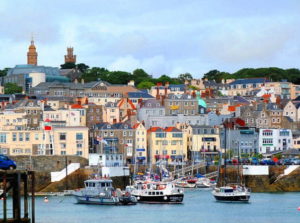
These two beautiful islands off the coasts of Brittany and Normandy form part of the larger group known in English-speaking countries as the Channel Islands, or les Iles de la Manche from the French perspective. Easily accessible by the regular car ferries plying back and forth from St Malo a couple of times a day, they offer a fascinating, and quite unique, addition to a European itinerary.
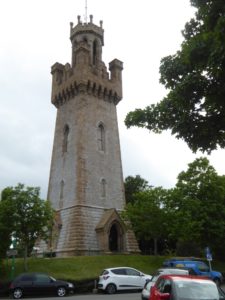
Although the islands are dependencies of the British crown with the Queen as official Head of State, they aren’t part of the UK, nor are they members of either the British Commonwealth or European Union, instead they are known as “Bailiwicks”.
Once part of the now-defunct Duchy of Normandy, one of the other chief landowners of the islands was the abbey of Mont St Michel. Separated from Normandy since 1204, each of these two islands has their own administrative systems which can be traced back to the customs of 13th century Normandy. They both have independent laws, elections and representative bodies, although the UK is responsible for defence and international relations. The islands have their own tax systems, and oddly (at least to us), their own currencies, and issue their own postage stamps. The two largest islands administer the other smaller ones in the group.
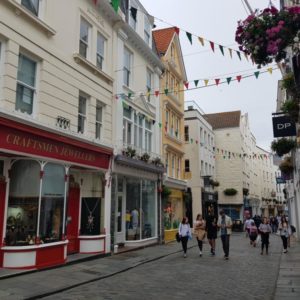
The islands’ Norman origins can still be discerned in the family names of many of the islanders, street signs and place names. Although English is the universal language, many inhabitants still speak a centuries-old patois based on Norman French.
The geography of the islands is rugged with dramatic cliffs plunging into the Atlantic, attractive fishing ports and coves, and undulating, gentle green
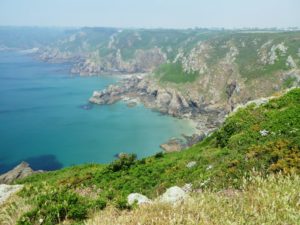
fields under agriculture and dotted with the famous Guernsey cows. Summers are very pleasant. Although never reaching very high temperatures, the Channel Islands are still said to be warmer than the UK. However, since it’s a maritime climate they can be prone to squalls, winds and fog.
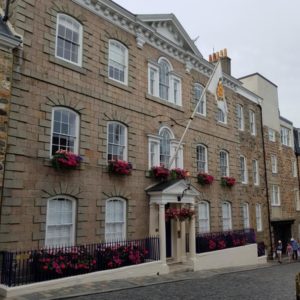
Nestling in the Bay of St Malo, Guernsey is smaller than Jersey, with a smaller town and perhaps less open countryside than Jersey. Nowadays, Guernsey is a favourite destination of holidaymakers and yachtsmen, but its early growth was largely thanks to smuggling and privateering, and one might say that this free enterprise spirit is alive and well today. The island is regarded as quite wealthy, thanks to its status as a tax haven, somewhat euphemistically referred to as “financial services”, evidenced by the numerous investment banks, funds managers and financial advisory services in the town.
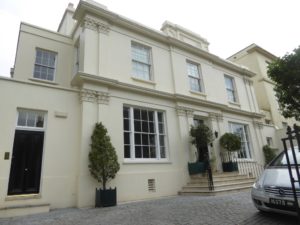
It’s clear that heritage is an important aspect of the island, given the care and respect afforded their historic buildings and natural sites, and the number of buildings that have been sensitively adapted for new uses. We were delighted to discover that the main town of Guernsey, St Peter Port, is a charming English Georgian town with pretty, pastel painted houses perched on steep streets, which must be quite challenging in wet weather.
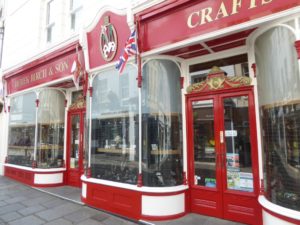
The commercial streets are lined with fine buildings, many of which still retain their beautiful, original shopfronts, narrow, cobblestone streets and a genteel air of prosperity.
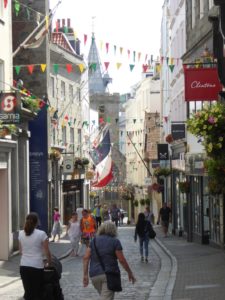
There are a number of established British retailers in the High Street such as Boots pharmacy, Marks & Spencer, Next, Monsoon, Miss Selfridge, Paperchase, and the very elegant Regent St. London jewellers, Mappin & Webb, who advertise that they’ve been in St Peter Port since the early 19th century.
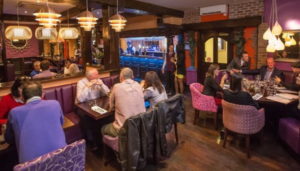
There are numerous attractive tea shops serving British high teas and the local fruit loaf called gâche (pronounced gosh), served with thick, golden Guernsey butter. As well, there are several authentic pubs offering the usual pub fare. One of the best though is the hotel we stayed in, the Duke of Normandie, whose in-house restaurant, ‘The Pickled Pig’, decorated in traditional British pub style, serves some of the best, most imaginative, modern food on the island.
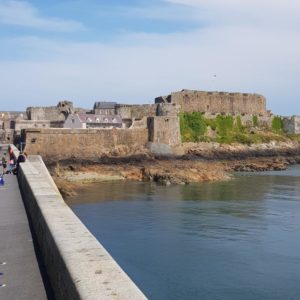
There are lovely beaches and secluded bays, woodland valleys, perilously narrow, picturesque country roads and stunning cliff-top walks. A prominent landmark is the 800 year old fort, Castle Cornet, guarding the entrance to the pretty St Peter Port harbour which has fascinating exhibits and ramparts to walk around. French writer, Victor Hugo lived on the island for 14 years, and installed his mistress next door to his home, Hauteville House, which is now a popular museum—currently undergoing restoration.
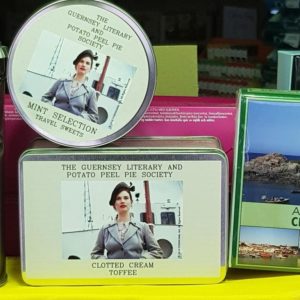
Since the recent release of the film, ‘The Guernsey Literary and Potato Peel Pie Society’, many non-islanders are aware that the islands were under Nazi occupation during WW2. The book (and to a lesser extent, the film) describes the hazards and hardships endured by the local population during those dark years of starvation and privation. It was adapted from diaries written by Peter de Sausmarez’s great aunt, Kathleen Scott. These were adapted into a novel firstly by Mary Ann Shaffer, and later by her niece Annie Barrows. Visitors can take a tour of Sausmarez Manor, mentioned in the book, and hear readings from the diaries.
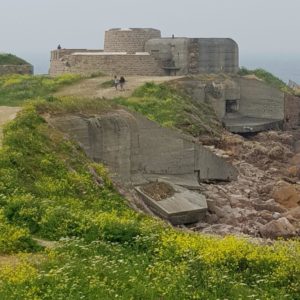
The extensive remains of the Nazi occupation are much in evidence, and quite a number of these are open to the public. It amazed us how enormous some of these are: both islands have huge concrete bunkers, gun emplacements and military installations. Guernsey has a number of huge tunnels, one of which was a military hospital that extends for an incredible distance under the hills.

Another are the six vast underground tunnels near St Peter Port that now houses the excellent La Valette Underground Military Museum with military collections and memorabilia from both World Wars.
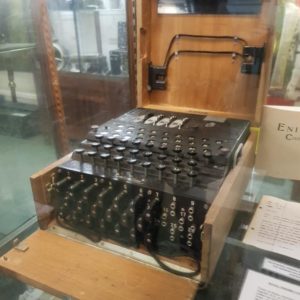
The German Occupation Museum walks the visitor through Guernsey’s wartime experience via weaponry, uniforms, a recreated wartime street, and a kitchen with the father listening to an illegal radio while the mother anxiously watches out for the Germans. There’s a fascinating collection of original documentation and memorabilia such as informers’ letters, memoires by islanders about their experiences in Nazi concentration camps, public notices setting out punishments for infringements and civil disobedience, as well as a startling diamond-studded swastika necklace! .
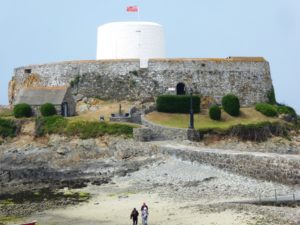
The most striking feature of Guernsey though is the island itself. Its beautiful coastline is dotted with stone Martello towers, most of which were constructed during the American War of Independence. Since the French sided with the Americans and as the Channel Islands remained loyal to Britain, there was a very real threat of French invasion.

There are remnants of Napoleonic-era defences such as Fort Grey, now the Maritime and Shipwreck Museum. Nearby is a very interesting display featuring the remains of a Roman trading vessel raised from the sea-bed. As you travel around the island you can also see the many menacing reminders of the Occupation.
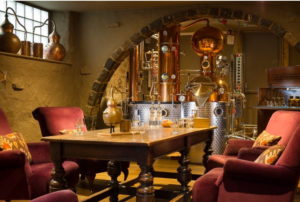
However, it’s not all reminders of disasters and past conflicts. The island has a number of local distilleries producing cider, gin, craft beers and fruit liqueurs flavoured with locally grown fruit and wild herbs.
Take a visit to the very pretty Candie Gardens, perched on a hillside with spectacular views overlooking St Peter Port. A delightful green space with statues to both Queen Victoria and Victor Hugo, the park is also the site of the Guernsey Museum and Art Gallery, and there’s an excellent café on site very popular with locals and visitors.
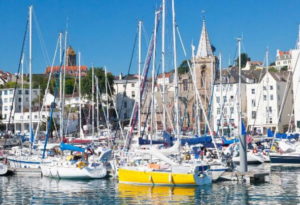
The Jersey Blog will follow shortly.


Hi Cheryl
We have very pleasant memories of staying in your apartments in Paris. You might remember that we met up with you and Graham at one of the nearby markets? We really enjoy these emails from you about your travels and have added many of these places to our bucket list.
The Channel Islands look fantastic.
Hi Jeff,
I remember you and Diane very well, and of course, our accidental meeting at the the market at Place Maubert! So glad you enjoy reading the Blogs and delighted they’ve inspired additions to your bucket list. Ours keeps on growing too, as there’s always fascinating destinations still “out there” to explore. You’re right about the Channel Islands–they’re incredibly interesting and like Belle Ile, where we were before heading to the Channel Is., we can’t imagine why we’d never managed to get there before, especialy as they’re so easy to get to. Next time, we’d like to explore a couple of the smaller islands, such as Sark. As I say, that list keeps on growing…!
Fascinating- in my ignorance I always assumed the islands were part of the UK. They’re now added to my bucket list.
We had thought that too! It came as some surprise to discover otherwise, and also the fact that they’ve got their own currencies in both Guernsey & Jersey, and stamps.
Hi Cheryl
I have really enjoyed your blogs, so much so, that we are making a return trip to France next year to explore Brittany and Normandy. We hope to visit Rochefort-en-Terre (subject of one of your other blogs) which looks fascinating. Also you have piqued our interest in a trip to Guernsey. I wonder how many days you recommend we stay on Guernsey? There certainly seems to be so much to see and do there.
Kind regards
Hi Sally,
Delighted that you are enjoying the blogs! I’d say that a minimum of 3 days on Guernsey, if you’re really pressed for time, and perhaps 4, if you can manage it. It’s easy to take a ferry from Guernsey across to Jersey, and the trip takes only about 45 mins. or thereabouts if I recall. If you’ve time, it’s really worth seeing both islands, as although they’ve got much in common, there’s a lot of differences, enough to make a trip to both worthwhile. I’d also strongly recommend that, if you’re coming and going from France, that St Malo is probably the easiest, with good ferry services to both Guernsey and Jersey. I’d really recommend our hotel on Guernsey, The Duke of Normandie, and it’s restaurant, ‘The Pickled Pig’, is rightly regarded as one of the best in Guernsey–very much upmarket pub, and good quality. There are certainly more upmarket hotels, but frankly, we thought this ticked all our boxes. Hiring a car to explore the island is really essential, as, although there are buses, the timetables aren’t terrific, and not frequent enough for the visitor to maximise their time–lots of frustrating waiting about. Let me know if you’ve got any particular queries, and I’d be delighted to try and help. If you’re heading to Paris, let me know if you’re interested in an apartment–I do know you’ve been a guest in the past–2015?? Once again, great to hear from you!
Best regards, Cheryl